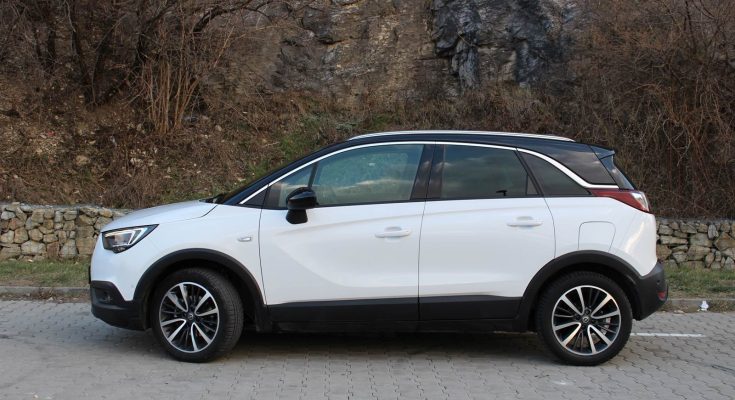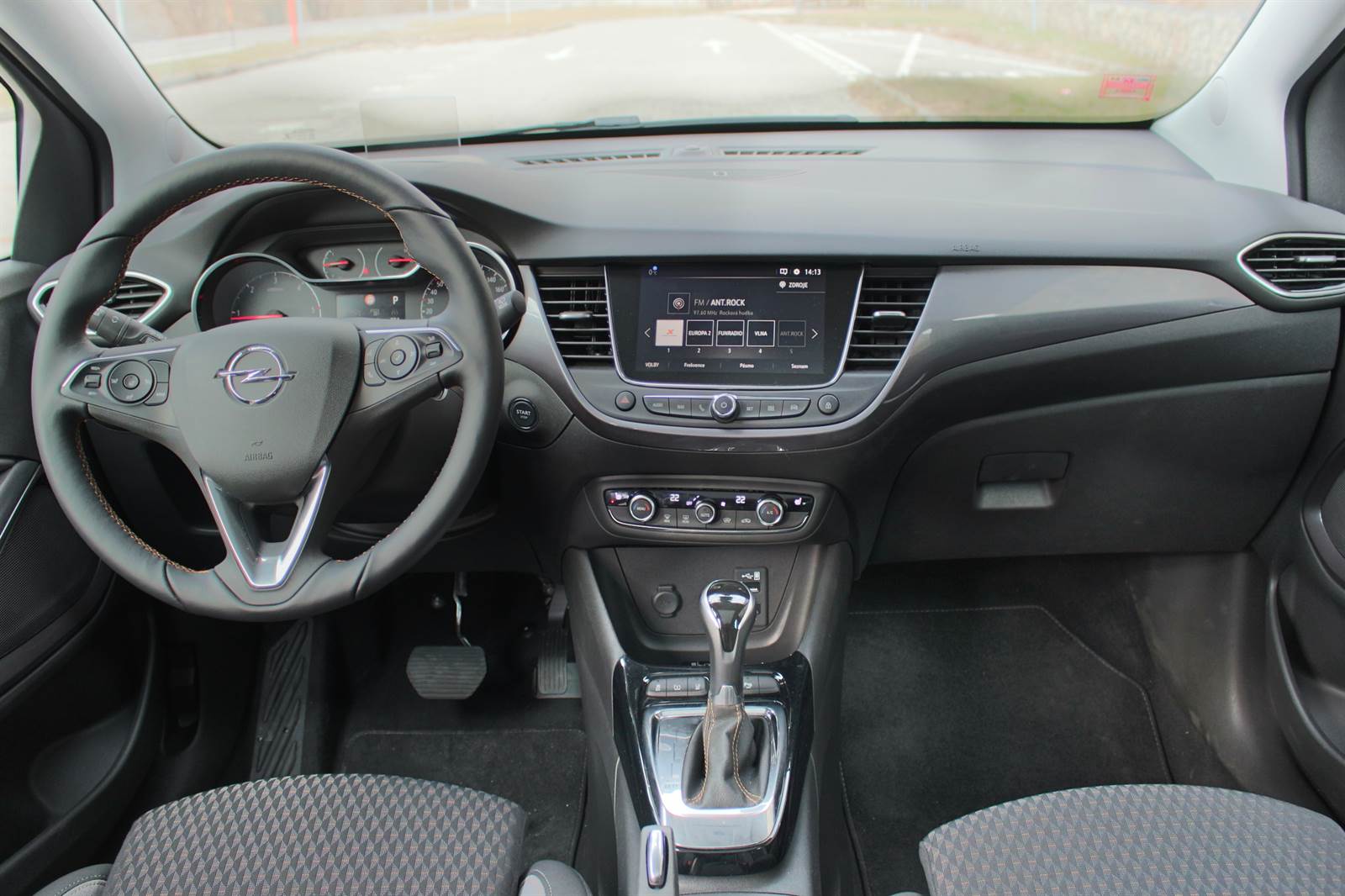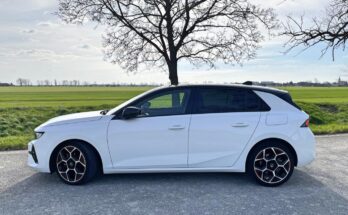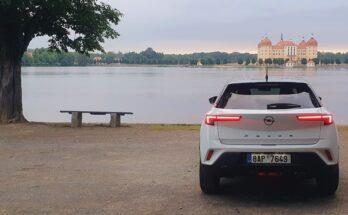The Crossland X model has been added to the Opel range. Its dimensions are strikingly reminiscent of its sister model, the Mokka X. However, unlike it, it does not have a 4×4 drive, offers less powerful engines, looks more modern and is profiled as an urban crossover. Like its larger sibling , the Grandland X is the result of the manufacturer's collaboration with the PSA concern. We test it in the top Ultimate trim, with a 1.5 CDTI diesel engine and an automatic 6-speed transmission.
From the outside
Even with this model, the manufacturer relied on a currently proven recipe. Taller body, "plastered" bumpers and sills, slightly above-average ground clearance… Boldly shaped chrome strip stretching from the bottom of the front window to the rear together with the black roof make this simply shaped car special. From the front, the car refers to the brand with the shape of the lights and their LED signature. On the other hand, if it weren't for the big emblem on the back, I wouldn't have guessed its belonging to the Opel family. Nevertheless, the car looks best on me from the rear side, where the contrast between the white metallic and the dark roof, effectively separated by the aforementioned chrome strip, stands out.
Inside
After opening the tall and heavy front door, I discover an interior strikingly similar to its bigger brother from the X family . The instrument panel, steering wheel, infotainment display, ventilation panel and automatic selector are taken over without change. The shaping of the massive dashboard, although covered with slightly less valuable materials, is equally inspired by the larger model. However, I evaluate this fact positively.
I was impressed by the unconventional shape of the manual handbrake and the design of the raised part of the central tunnel, into which the automatic transmission selector is inserted. I also liked the upholstery of the seats, the combination of leatherette and different colored textiles brightens up the mostly dark interior.
Opel infotainment is one of the best. Its control is intuitive and clear. I must also express my satisfaction with the Android Auto/Apple Car play support.
Driving
The manufacturer paid a lot of attention to the shaping of the seats. In this class, I would like to highlight the above-average adjustment options, which allow every driver to sit comfortably (lumbar support adjustment in four directions, adjustment of the seat inclination, its extension). However, the combination of the position of the seats, pedals and steering wheel did not allow me to find an ideal position with my legs stretched forward at my height of 185 cm. The pedals were placed too close or the longitudinal adjustment of the steering wheel did not allow me to move the seat further from them. However, lower characters will not have a problem.
The space in front was generously dimensioned in terms of width and height. At the feet, however, I was limited by the overly protruding and narrow support of the left leg. The folding armrest fixed on the driver's seat fulfilled its role well enough, however, I would rather have welcomed its standard version, which would be part of the central tunnel and could also serve the passenger.
The wide A-pillars at the bottom slightly spoiled the excellent view in all directions. I was also satisfied with the size of the rear-view mirrors.
The ergonomics of the controls are at a decent level. I got used to the higher basic position of the levers under the steering wheel, but I consider it unnecessary to control the direction of ventilation via the infotainment display.
After a good experience with the driving characteristics of the Grandland X model, I naturally had similar expectations from the test car. The chassis is tuned relatively stiff and handles larger bumps only to a limited extent on 17" wheels. The car leans more significantly in corners, which discourages the driver from going through them at a higher speed. However, when overcoming the unpleasant feeling of tilting, the chassis can maintain the trail for a relatively long time. However, I certainly wouldn't call the CrosslandX a "driver's" car suitable for quickly sweeping the streets.
His main place of work will be city streets. Maneuvering the car is easy thanks to the 11-meter turning diameter and abundant glazing. However, the number of turns of the steering wheel between its extreme positions could have been lower (3). Parking is facilitated by the rear camera and sensors on both ends of the body.
When driving on the highway, I was surprised by the low level of aerodynamic noise. Rather, the noise penetrates from the chassis and the engine. Driving at higher speeds is comfortable with surprisingly low crosswind sensitivity. I liked the stiff steering without play and with the same power steering resistance in every position of the steering wheel.
The car was powered by a four-cylinder diesel unit with a volume of 1499 cm 3 , a maximum output of 88 kW at 3750 rpm and a torque of 300 Nm at 1750 rpm. The engine exhibits relatively strong noise and vibration after starting, after warming up the vibration disappears and the noise drops to an acceptable level. The one-five is manifested by a decent diesel pull from low revs and only a short delay in the reaction to the gas pedal. From low speeds, the car can accelerate quite significantly, at higher speeds the acceleration is only gradual. I was satisfied with the logic and smoothness of the shifting of the automatic transmission with the hydrodynamic converter. It makes perfect use of the range of usable engine revolutions and does not try to "under-rev" it. The shifting speed is only average, but in connection with this engine, I did not find it disturbing.
A pleasant feature of the tested engine was the ability to keep the car's appetite at bay under all circumstances. I drove in minus temperatures on wet roads with a combined consumption of 5.6 l/100 km. I used 5.1 l/100 km in the districts and 6.1 l/100 km on the highways. In the city, I was able to fit in a value of 6.5 in average traffic. It is not a problem to get close to four liters on the expressway with a speed limit of 100 km/h.
Practical side, equipment, price
Unlike the front seats, there was significantly less space for adult passengers in the back. Families with small children will appreciate the easy installation of child seats in the isoFix mounts and the possibility of sliding and adjusting the inclination of the rear seats. When they are folded down, the luggage compartment forms a flat area with a volume of 1255 l. Its basic volume can be changed by moving the rear bench or its part in the range of 410-520l. I was satisfied with the number and volume of storage folders.
The base price of the tested car in Ultimate trim is EUR 23,590, with accessories and metallics it climbs several thousand EUR higher. I consider the price to be acceptable, moreover, it is often reduced by traditional promotions and the fleet program of the Opel brand.
Verdict
I can say for myself that CrosslandX did not completely capture my heart. However, I appreciate that Opel built a car with a traditional interior, which appeals to a still large group of conservative customers. With the variability of the rear part, it focused on the practical side and also convinces with its low operating costs. Only the number of units sold will show whether customers will prefer the Crossland X or remain loyal to the older Mokka X model.









